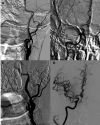Emergent carotid artery stenting in patients with acute ischemic stroke due to cervical internal carotid artery steno-occlusive lesion: Comparison of tandem intracranial occlusion and isolated cervical internal carotid artery occlusion
- PMID: 31992107
- PMCID: PMC7446583
- DOI: 10.1177/1591019919899755
Emergent carotid artery stenting in patients with acute ischemic stroke due to cervical internal carotid artery steno-occlusive lesion: Comparison of tandem intracranial occlusion and isolated cervical internal carotid artery occlusion
Abstract
Purpose: Acute ischemic strokes caused by steno-occlusive lesion of the cervical internal carotid artery are associated with poor clinical outcome. We evaluated the clinical efficacy of emergent carotid artery stenting for the management of these lesions. We compared the clinical outcomes regarding the intracranial lesion, namely tandem occlusions versus isolated cervical internal carotid artery occlusion.
Materials and methods: We retrospectively reviewed patients with acute ischemic stroke who underwent carotid artery stenting for cervical internal carotid artery steno-occlusive lesion between 2011 and 2018. After dividing the patients into two groups according to the presence or absence of intracranial lesions (tandem group and isolated cervical group), we analyzed demographic data, angiographic findings, and clinical outcomes. A modified Rankin Scale score ≤2 was defined as a favorable clinical outcome.
Results: Of 75 patients, 46 patients (61.3%) had tandem lesions, and the remaining 29 had only cervical internal carotid artery steno-occlusive lesion. Successful stenting was performed in all patients with favorable clinical outcomes (64.0%). Successful reperfusion score (thrombolysis in cerebral infarction ≥2 b) was 84.0%; tandem group (76.1%) versus isolated cervical group (96.6%) of cases. Mean modified Rankin Scale score at 90-days was 2.09. The rate of favorable clinical outcome showed no statistically significant difference between the two groups (p = 0.454).
Conclusions: Endovascular treatment in patients with acute ischemic stroke due to cervical internal carotid artery steno-occlusive lesion is a technically feasible and clinically effective intervention regardless of intracranial occlusion. Therefore, we recommend endovascular treatment regardless of the presence of concomitant intracranial artery occlusion for patients with acute ischemic stroke caused by cervical internal carotid artery steno-occlusive lesion.
Keywords: Carotid artery; arterial occlusive diseases; endovascular procedures; stents; stroke.
Figures



Similar articles
-
Safety and Outcome of Carotid Dissection Stenting During the Treatment of Tandem Occlusions: A Pooled Analysis of TITAN and ETIS.Stroke. 2020 Dec;51(12):3713-3718. doi: 10.1161/STROKEAHA.120.030038. Epub 2020 Nov 10. Stroke. 2020. PMID: 33167809
-
Emergent Carotid Stenting During Thrombectomy in Tandem Occlusions Secondary to Dissection: A STOP-CAD Secondary Study.Stroke. 2025 Apr;56(4):808-817. doi: 10.1161/STROKEAHA.124.048295. Epub 2025 Jan 30. Stroke. 2025. PMID: 39882629
-
Effect of emergent carotid stenting during endovascular therapy for acute anterior circulation stroke patients with tandem occlusion: A multicenter, randomized, clinical trial (TITAN) protocol.Int J Stroke. 2021 Apr;16(3):342-348. doi: 10.1177/1747493020929948. Epub 2020 Jun 9. Int J Stroke. 2021. PMID: 32515696
-
Revascularization of carotid artery occlusion using stenting versus non stenting in endovascular management of tandem occlusion stroke.J Clin Neurosci. 2022 Apr;98:15-20. doi: 10.1016/j.jocn.2022.01.036. Epub 2022 Feb 4. J Clin Neurosci. 2022. PMID: 35131720 Review.
-
Endovascular Treatment of Acute Ischemic Stroke Due to Tandem Occlusions: Large Multicenter Series and Systematic Review.Cerebrovasc Dis. 2016;41(5-6):306-12. doi: 10.1159/000444069. Epub 2016 Feb 17. Cerebrovasc Dis. 2016. PMID: 26881779
Cited by
-
Is Crash Loading Acceptable in Carotid Artery Stenting? : Results of Antiplatelet Crash Loading vs. Semi-crash vs. Elective Loading in a Large Study Population.Clin Neuroradiol. 2023 Jun;33(2):415-425. doi: 10.1007/s00062-022-01222-6. Epub 2022 Oct 20. Clin Neuroradiol. 2023. PMID: 36264353 Free PMC article.
-
Diagnosis and treatment of acute isolated proximal internal carotid artery occlusions: a narrative review.Ther Adv Neurol Disord. 2022 Nov 21;15:17562864221136335. doi: 10.1177/17562864221136335. eCollection 2022. Ther Adv Neurol Disord. 2022. PMID: 36437850 Free PMC article. Review.
-
A multi-center study of the MicroNET-covered stent in consecutive patients with acute carotid-related stroke: SAFEGUARD-STROKE.Postepy Kardiol Interwencyjnej. 2024 Jun;20(2):172-193. doi: 10.5114/aic.2024.140963. Epub 2024 Jun 30. Postepy Kardiol Interwencyjnej. 2024. PMID: 39022700 Free PMC article.
-
Hyperacute stenting and angioplasty for acute extracranial non-tandem internal carotid artery strokes within the first 48 h: A 20-year experience and a systematic review and meta-analysis.Interv Neuroradiol. 2025 Jun;31(3):352-363. doi: 10.1177/15910199231164510. Epub 2023 May 22. Interv Neuroradiol. 2025. PMID: 37218164 Free PMC article.
-
Diagnostic accuracy of large and medium vessel occlusions in acute stroke imaging by neurology residents and stroke fellows: A comparison of CT angiography alone and CT angiography with CT perfusion.Eur Stroke J. 2024 Jun;9(2):356-365. doi: 10.1177/23969873231214218. Epub 2023 Nov 21. Eur Stroke J. 2024. PMID: 37990504 Free PMC article.
References
-
- Powers WJ, Rabinstein AA, Ackerson T, et al. 2018 Guidelines for the early management of patients with acute ischemic stroke: a guideline for healthcare professionals from the American Heart Association/American Stroke Association. Stroke 2018; 49: e46–e110. - PubMed
-
- Mokin M, Kass-Hout T, Kass-Hout O, et al. Intravenous thrombolysis and endovascular therapy for acute ischemic stroke with internal carotid artery occlusion: a systematic review of clinical outcomes. Stroke 2012; 43: 2362–2368. - PubMed
-
- Jovin TG, Chamorro A, Cobo E, et al. Thrombectomy within 8 hours after symptom onset in ischemic stroke. N Engl J Med 2015; 372: 2296–2306. - PubMed
-
- Grau AJ, Weimar C, Buggle F, et al. Risk factors, outcome, and treatment in subtypes of ischemic stroke: the German stroke data bank. Stroke 2001; 32: 2559–2566. - PubMed
-
- Ioannis C, Felberg RA, Demchuk AM, et al. Intravenous tissue plasminogen activator and flow improvement in acute ischemic stroke patients with internal carotid artery occlusion. J Neuroimag 2002; 12: 119–123. - PubMed
Publication types
MeSH terms
LinkOut - more resources
Full Text Sources
Medical

